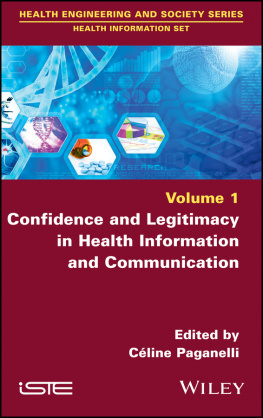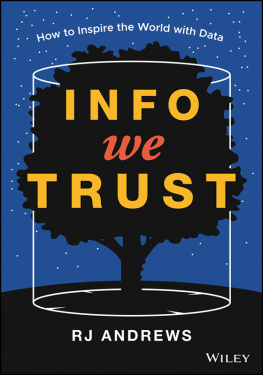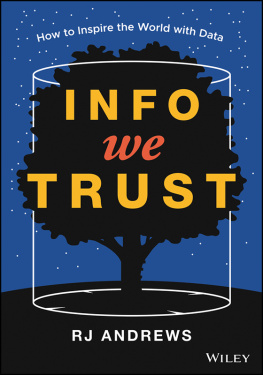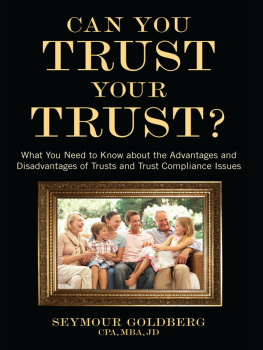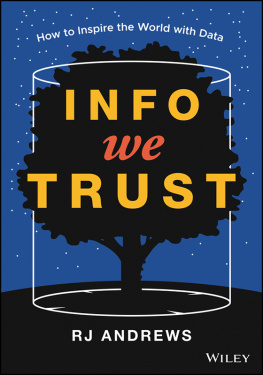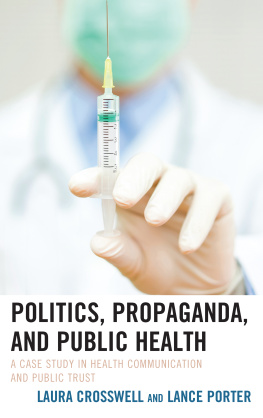
Health Information Set
coordinated by
Cline Paganelli and Viviane Clavier
Volume 1
Confidence and Legitimacy in Health Information and Communication
Edited by
Cline Paganelli
First published 2018 in Great Britain and the United States by ISTE Ltd and John Wiley & Sons, Inc.
Apart from any fair dealing for the purposes of research or private study, or criticism or review, as permitted under the Copyright, Designs and Patents Act 1988, this publication may only be reproduced, stored or transmitted, in any form or by any means, with the prior permission in writing of the publishers, or in the case of reprographic reproduction in accordance with the terms and licenses issued by the CLA. Enquiries concerning reproduction outside these terms should be sent to the publishers at the undermentioned address:
ISTE Ltd
27-37 St Georges Road
London SW19 4EU
UK
www.iste.co.uk
John Wiley & Sons, Inc.
111 River Street
Hoboken, NJ 07030
USA
www.wiley.com
ISTE Ltd 2018
The rights of Cline Paganelli to be identified as the author of this work have been asserted by her in accordance with the Copyright, Designs and Patents Act 1988.
Library of Congress Control Number: 2018949573
British Library Cataloguing-in-Publication Data
A CIP record for this book is available from the British Library
ISBN 978-1-78630-352-3
Preface
This is the first book of a series entitled Health-Information Seeking coordinated by Cline Paganelli and Viviane Clavier. This series is part of the collection Health Engineering and Society proposed by Bruno Salgues. Each book in the series deals with a specific editorial project designed in close collaboration with the directors of the books.
In this book, we propose questioning the notions of trust and legitimacy in information communication in the field of health. It is the result of a call for contributions. The chapters of this book are subjected to a double-blind evaluation of the contributions, first in a summative form and then in full chapter form. Cline Paganelli warmly thanks the following members of the scientific committee:
Viviane Clavier, MCF HDR in Information and Communication Sciences, Grenoble Alpes University, Gresec;
Viviane Couzinet, professor of Information and Communication Sciences, Paul Sabatier University, Lerass;
Mabrouka El Hachani, MCF in Information and Communication Sciences, Lyon-3 University, Elico;
Jolle Kivits, MCF, Nancy School of Public Health, Lorraine University;
Marc Lemire, Ph.D. Institutional Researcher at the Institut national de sant publique du Qubec (INSPQ), School of Public Health, University of Montreal;
Joseph Lvy, Professor, University of Quebec in Montreal;
Dominique Maurel, Associate Professor, EBSI, Montreal;
Cline Paganelli, MCF HDR in Information and Communication Sciences, Paul-Valry Montpellier 3 University, Lerass-Ceric;
Isabelle Pailliart, professor of Information and Communication Sciences, Grenoble Alpes University, Gresec;
Bruno Salgues, Director of studies, Institut Mines-Telecom, Paris;
Anne-Lise Touboul, MCF in Information and Communication Sciences, Lyon-2 University, Elico;
Lise Verlaet, MCF in Information and Communication Sciences, Paul-Valry Montpellier 3 University, Lerass-Ceric.
Preface written by Cline PAGANELLI.
Introduction
The question of trust is crucial in the field of health because health is indicative of particularly strong issues, be it societal, regulatory, institutional or individual as well as because the boundaries between specialized information validated by legitimate bodies such as institutions or professionals of the sector and information that has not been validated have become permeable. The final reason is that trust appears to be central within relationships between actors in the field, whether they are professionals, patients, public authorities, companies or health organizations. The issue of trust is most often dealt with from the viewpoint of the relationship between patients and health professionals or between users and their health system [JAU 03, SAO 09].
In this book, we propose a method of addressing trust in terms of information and communication phenomena that are at work in the health sector and consider the process of building the legitimacy of information in the health sector.
The forms of production, editorialization and mediation of specialized information in the field of medicine have undergone a large number of changes in recent years, particularly under the influence of information and communication technologies. These developments have affected the health information sector, considered here as information for the general public, especially through the development of discussion forums and websites for generalists and most often from private players. Specialized medical information, which is part of the field of professional information and intended for industry players (especially health professionals), has also undergone profound changes. Traditionally produced by the public sector or specialized publishers, it has seen the multiplication of production bodies: pharmaceutical laboratories, patient associations, doctors, etc.; information validation circuits, where they exist, have also diversified.
These transformations accompany other developments in the field of medicine. The development of the medical Internet, the setting up of patient files and telemedicine have led us to reexamine the question of confidence in the field of health, whether it is in the relationships between actors, compared to the information found on the Internet, disseminated by institutions or obtained from professionals, or in relationships that are formed with information-communication devices, including medical information systems. Finally, discourses on patient empowerment, whether they come from public authorities or health institutions, lead us to consider this movement by questioning the notions associated with it, such as autonomy, understanding, participation or even trust.
The Trsor de la Langue Franaise defines trust as the spontaneous or acquired belief in the moral, emotional, professional value of another person. According to the philosopher Michela Marzano, trust refers to the idea that one can trust someone or something. In particular, she wrote, the verb confide (from the Latin confidere: cum, with and fidere, proud) means, indeed, that something precious is given to someone, trusting him and thus abandoning yourself to his goodness and his good faith [MAR 10]. Thus, we trust a person or device that we consider reliable based on our own criteria. Confidence also refers to a sense of security: a climate of trust evoking a situation that appears reassuring. In the presentation of one of the Rseaux editions published in 2001 about trust, Louis Qur was interested in its other aspects, such as the inter-organizational trust mentioned by Edward Lorenz and the conditions favoring it.
Here, we connect trust and legitimacy by proposing to question the way in which the legitimacy of information is built, particularly in information-communication devices in the field of health. Certifying health information sites by the Health On the Net (HON) Foundation, accredited by the Haute Autorit de Sant (HAS), is an example of the legitimization of health information intended to give reliability that provides guarantees and, therefore, trust to users. However, the conventional criteria of peer evaluation as practiced in the context of scientific publication activity cannot be applied during mass dissemination of medical information, since health professionals cannot respond to a large number of requests. Validation of content is lacking [REN 09]; legitimacy is exercised in the field of information quality, certified or labeled, which can be identified by a logo said to be of quality. In this context, the legitimacy conferred by the attribution of a quality logo appears above all as a guarantee of credibility for site publishers, which does not necessarily result in a higher visitor rate. This raises the question of the criteria used by Internet users to trust health information sites, as well as the question of the different forms of certification put in place by producers of health information services.
Next page
